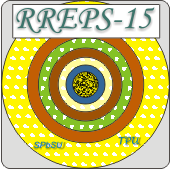Speaker
Vasily Sukharev
(National Research Nuclear University (MEPhI))
Description
When a relativistic charged particle moves near the surface, field of the particle excites oscillations of the atomic electrons, so the polarization currents arise, giving birth to the secondary electromagnetic field – polarization radiation (PR). If a charged particle moves with constant velocity along the inhomogeneous medium, PR is called diffraction radiation (DR) [1].
It is of interest to investigate DR from spiral-shaped target, arising when a relativistic charged particle moves along the axis of the spiral. The target has its own periodicity, but it slightly differs from the problem of Smith-Purcell (SP) effect [2], due to helical form of the target, when an element of the target repeats over and over with a free space in between.
The problem is solved in a zero approximation, using polarization currents method [3]. Even this simple approach demonstrates typical SP behavior specific to this kind of problems.
1. A.P. Potylitsyn, M.I. Ryazanov, M.N. Strikhanov, A.A. Tishchenko, Diffraction Radiation from Relativistic Particles, Springer, ISBN 978-3-642-12513-3 (2011).
2. S. J. Smith and E. M. Purcell, Visible Light from Localized Surface Charges Moving across a Grating, Phys. Rev. 92, 1069 (1953).
3. L. Durand, Transition radiation from ultrarelativistic particles, Phys. Rev. D 11, 89 (1975).
Author
Vasily Sukharev
(National Research Nuclear University (MEPhI))
Co-authors
Dr
Alexey Tishchenko
(National Research Nuclear University (MEPhI))
Prof.
Mikhail Strikhanov
(National Research Nuclear University (MEPhI))
